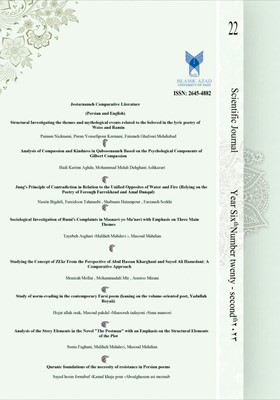-
-
List of Articles
-
Open Access Article
1 - Investigating the themes and mythological events related to the beloved in the lyric poetry of Weiss and Ramin
Paiman niknami Pouran Yousefipour Kermani Fatemeh Ghafouri Mehdiabad -
Open Access Article
2 - Analysis of Compassion and Kindness in Qaboosnameh Based on the Psychological Components of Gilbert Compassion
. Hadi Karimi Aghda . Mohammad Mehdi Dehghani Ashkazari -
Open Access Article
3 - Jung's Principle of Contradiction in Relation to the Unified Opposites of Water and Fire (Relying on the Poetry of Forough Farrokhzad and Amal Dunqul)
Nasrin Bigdeli Fereydoon Tahmasbi Shabnam Hatampour Farzaneh Sorkhi -
Open Access Article
4 - Sociological Investigation of Rumi's Complaints in Masnavi-ye-Ma'navi with Emphasis on Three Main Themes
Tayebeh Asghari Maliheh Mahdavi Masoud Mahdian -
Open Access Article
5 - Comparative approach; studying the concept of dhikr from the perspective of Abolhassan Kharghani and Seyed Ali Hamedani
monira mollaee mohammadali mir ARASTOO MIRANI -
Open Access Article
6 - study of contemporary Persian poetry in contemporary Persian poetry (based on the volume of the poet, Yadallah Royaei)
hojatolah orak Masoud Pakdel Mansoureh Tadayoni Sima Mansoori -
Open Access Article
7 - Analysis of Story Elements in the "Postchi" Novel with Emphasis on the Structural Elements of the Plot
Sonia Faghani Maliheh Mahdavi Masoud Mahdian -
Open Access Article
8 - Quranic foundations of the necessity of resistance in Persian poems
sayyd hosin formibaf kamal khajepour aboalghasem asi moznab
-
The rights to this website are owned by the Raimag Press Management System.
Copyright © 2021-2025







